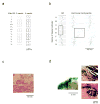Molecular ablation of ventricular tachycardia after myocardial infarction
- PMID: 17072309
- PMCID: PMC1783685
- DOI: 10.1038/nm1503
Molecular ablation of ventricular tachycardia after myocardial infarction
Abstract
Ventricular tachycardia is a common and lethal complication after myocardial infarction. Here we show that focal transfer of a gene encoding a dominant-negative version of the KCNH2 potassium channel (KCNH2-G628S) to the infarct scar border eliminated all ventricular arrhythmias in a porcine model. No proarrhythmia or other negative effects were discernable. Our results demonstrate the potential viability of gene therapy for ablation of ventricular arrhythmias.
Figures


Similar articles
-
Gene therapy approaches to ventricular tachyarrhythmias.J Electrocardiol. 2007 Nov-Dec;40(6 Suppl):S187-91. doi: 10.1016/j.jelectrocard.2007.05.036. J Electrocardiol. 2007. PMID: 17993320 Free PMC article.
-
Ventricular tachycardia from the healed myocardial infarction scar: validation of an animal model and utility of gene therapy.Heart Rhythm. 2009 Aug;6(8 Suppl):S91-7. doi: 10.1016/j.hrthm.2009.03.048. Epub 2009 Apr 1. Heart Rhythm. 2009. PMID: 19631912 Free PMC article.
-
Short QT syndrome. What is it? Where is it?Indian Heart J. 2005 Nov-Dec;57(6):769-71. Indian Heart J. 2005. PMID: 16521657 Review. No abstract available.
-
Selective molecular potassium channel blockade prevents atrial fibrillation.Circulation. 2010 Jun 1;121(21):2263-70. doi: 10.1161/CIRCULATIONAHA.109.911156. Epub 2010 May 17. Circulation. 2010. PMID: 20479154 Free PMC article.
-
Molecular genetic basis of sudden cardiac death.Pediatr Clin North Am. 2004 Oct;51(5):1229-55. doi: 10.1016/j.pcl.2004.04.012. Pediatr Clin North Am. 2004. PMID: 15331282 Review.
Cited by
-
Heterogeneous repolarization creates ventricular tachycardia circuits in healed myocardial infarction scar.Nat Commun. 2022 Feb 11;13(1):830. doi: 10.1038/s41467-022-28418-1. Nat Commun. 2022. PMID: 35149693 Free PMC article.
-
Allogeneic cardiospheres delivered via percutaneous transendocardial injection increase viable myocardium, decrease scar size, and attenuate cardiac dilatation in porcine ischemic cardiomyopathy.PLoS One. 2014 Dec 2;9(12):e113805. doi: 10.1371/journal.pone.0113805. eCollection 2014. PLoS One. 2014. PMID: 25460005 Free PMC article.
-
Tachycardia in post-infarction hearts: insights from 3D image-based ventricular models.PLoS One. 2013 Jul 2;8(7):e68872. doi: 10.1371/journal.pone.0068872. Print 2013. PLoS One. 2013. PMID: 23844245 Free PMC article.
-
Gene Therapy for Cardiac Arrhythmias.Acta Cardiol Sin. 2013 May;29(3):226-34. Acta Cardiol Sin. 2013. PMID: 27122711 Free PMC article. Review.
-
Targeted high-efficiency, homogeneous myocardial gene transfer.J Mol Cell Cardiol. 2007 May;42(5):954-61. doi: 10.1016/j.yjmcc.2007.02.004. Epub 2007 Feb 14. J Mol Cell Cardiol. 2007. PMID: 17484913 Free PMC article.
References
-
- American Heart Association, 2001. Heart and Stroke Statistical Update. American Heart Association; Dallas, TX: 2002.
-
- Rothman S, et al. Circulation. 1997;96:3499–3508. - PubMed
-
- Gould P, Krahn A Canadian Heart Rhythm Society Working Group on Device Advisories. JAMA. 2006;295:1907–1911. - PubMed
-
- Maisel W, et al. JAMA. 2006;295:1901–1906. - PubMed
Publication types
MeSH terms
Substances
Grants and funding
LinkOut - more resources
Full Text Sources
Other Literature Sources
Medical

